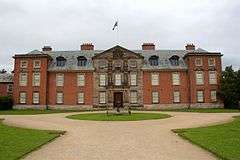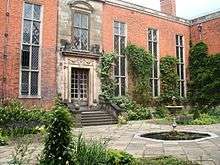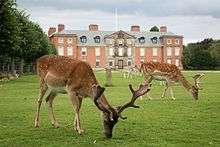Dunham Massey Hall
| Dunham Massey Hall | |
|---|---|
 | |
| Alternative names |
Dunham Massey; Stamford Military Hospital |
| Website | |
|
www | |

Dunham Massey Hall, usually known simply as Dunham Massey[1] is an English country house in the parish of Dunham Massey in the district of Trafford,[2] near Altrincham, Cheshire, and close to the edge of Greater Manchester. It is now a National Trust property, open to the public.[1] During World War I it was the Stamford Military Hospital,[3]
The stately home was designated a Grade One listed-building on 5 March 1959.[2] It has been owned by the National Trust since the death of the 10th and last Earl of Stamford in 1976.[4] Over 340,000 people visited the house in 2014/15, placing it in the ten most popular National Trust houses.[5]
Dunham Massey was built from the 1730s by the Earls of Warrington, passing to the Earls of Stamford by inheritance; the family still live in part of the house. There were significant alterations, especially internally, at the start of the 20th century.[6] It has historic formal gardens and a deer park. It was formerly in the ancient parish of Bowdon, Cheshire.
Main house

The double courtyard house is built of Flemish bond brick, stone dressings, and a roof of Westmorland and Welsh slate.[2] The external architecture is relatively plain,[7] and was even more so until the house was modified in 1905-08 by Compton Hall. Until this time, the southern front of the building had 11 three-storey bays; in order to make the building look more 17th-century in style the 3rd, 4th, 8th and 9th bays were reduced to two stories with dormers, and a centrepiece of 3 bays was added, with columns each side of the central bay, and stone pediments.[2]
Internally, the service rooms such as the kitchen have changed little for over a century, and have been restored to reflect their use then.[8] The mansion's service court dates from circa 1721.[2] The clock tower is inscribed with that date, suggesting that was when improvements were made to the stables. In the 1730s John Norris was brought in to redesign the whole mansion by the 2nd Earl of Warrington, with a design of brick façade accentuated by bays and a stone centerpiece.[9]
Stamford Military Hospital

During World War One Penelope, Countess of Stamford, made the stately home available to the Red Cross as a military hospital, becoming known as the Stamford Military Hospital from April 1917 to January 1919. It hosted 182 injured soldiers who had suffered injuries and needed medical care, but not life-threatening, ranging from gas poisoning to bullets in the brain. The hospital was run by Sister Catherine Bennett, and Lady Stamford's daughter, Lady Jane Grey (later Turnbull),[10] trained as a nurse at the hospital.[3][11]
From 1 March 2014 until 11 November 2016, the main ward at Stamford Military Hospital (known as "Baghdad"), along with the operating theatre, nurses' station and the recreation room were recreated to commemorate the 100-year anniversary of the start of World War One,[3] along with actors playing the role of characters who worked, lived and recovered at the hospital.[11][12]
Contents

Dunham Massey contains one of the largest collections of Huguenot silver, largely collected by George Booth, 2nd Earl of Warrington. During his 64 years at Dunham Massey, he accumulated over 1000 pieces of silver. One sixth of the original plate remains at Dunham Massey, with much of the collection being dispersed by the Countess of Stamford and Warrington (who died in 1905), widow of George, Earl of Stamford and Warrington (died 1883). The 10th Earl, Roger Grey, expended much money and effort in returning family heirlooms originally from Dunham Massey.[13]
There is a fine collection of oil paintings and watercolours. The relief wood-carving of the Crucifixion by Grinling Gibbons, which hangs in the Library, is the earliest known work by the 17th-century wood carver. It is on this piece of work he was working when he was discovered by John Evelyn in 1671. A group of paintings of the house and estate from the 1690s and 1750s are described by Simon Jenkins as "the most remarkable topographical survey of any country house and its grounds to remain in situ. These are in the Great Gallery, which also has an Allegory of Time by Guercino.[14]
Other buildings

The Carriage House, located south of the kitchen courtyard, is also Grade 1 listed. It has a clock turret, which displays a date of 1721.[15]
Also located south of the Hall are the stable buildings are also Grade 1 listed. They probably date from 1721, but the west side was extended in the 18th century.[16] The Stables Restaurant is located in the upstairs of the South Stables, with an ice cream parlour below. The Stables will be accessible to visitors as part of a new interpretation and conservation project in May 2016.
Gardens and park

The gardens houses over 700 plant species, as well as 1,600 trees and shrubs, and it hosts the largest winter garden in Britain.[4] The Winter Garden has many snowdrops, daffodils and bluebells.[17]
The 300 acre[4] deer park at Dunham Massey dates back to medieval times.[18] The oldest surviving building on the Dunham Estate is the Mill.[18]
Notes
- 1 2 "Dunham Massey". National Trust. Retrieved 21 February 2016.
- 1 2 3 4 5 "Dunham Hall". Historic England. Retrieved 21 February 2016.
- 1 2 3 "First World War hospital to be recreated at National Trust's Dunham Massey Hall". 1914. 5 November 2013. Retrieved 21 February 2016.
- 1 2 3 "A walk in the grounds of Dunham Massey". Guardian. 12 May 2012. Retrieved 21 February 2016.
- ↑ National Trust 2014/15 Annual Report, 71
- ↑ Jenkins, 79-80
- ↑ Jenkins, 79-80
- ↑ Jenkins, 79-80
- ↑ The National Trust (2000). Dunham Massey.
- ↑ www.cracroftspeerage.co.uk
- 1 2 "First World War Centenary: Dunham Massey Hall reconverted into a hospital". Independent. 4 March 2014. Retrieved 21 February 2016.
- ↑ "Bringing history to life". National Trust. Retrieved 21 February 2016.
- ↑ The National Trust (2000). Dunham Massey. pp. 29–30.
- ↑ Jenkins, 80
- ↑ "Carriage House Immediately To South Of Kitchen Courtyard". Historic England. Retrieved 21 February 2016.
- ↑ "Stables To South Of Hall". Historic England. Retrieved 21 February 2016.
- ↑ "See the Garden spring to life". National Trust. Retrieved 21 February 2016.
- 1 2 "A perfect parkland". National Trust. Retrieved 21 February 2016.
References
- Jenkins, Simon, England's Thousand Best Houses, 2003, Allen Lane, ISBN 0-7139-9596-3 (gives 3 stars)
| Wikimedia Commons has media related to Dunham Massey Hall. |
External links
Coordinates: 53°22′58″N 2°24′00″W / 53.3827°N 2.4000°W